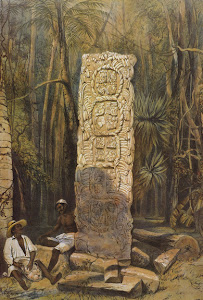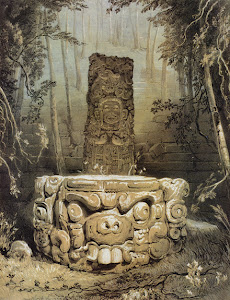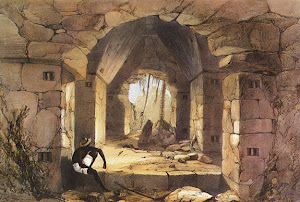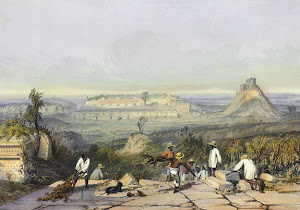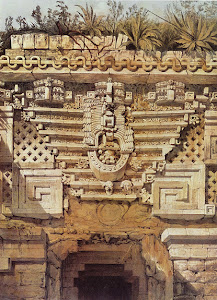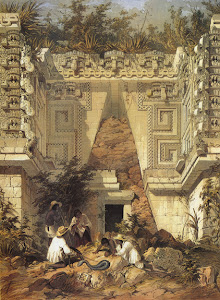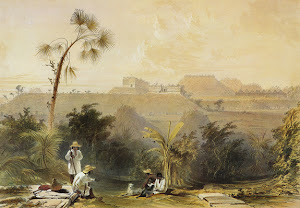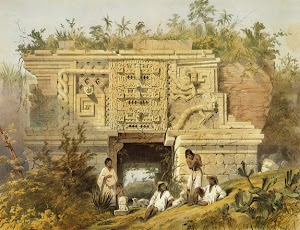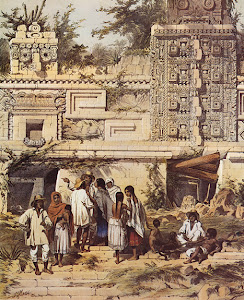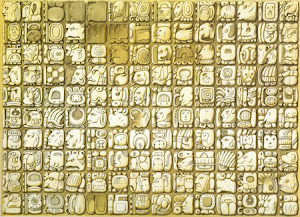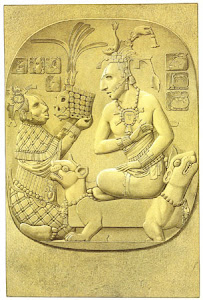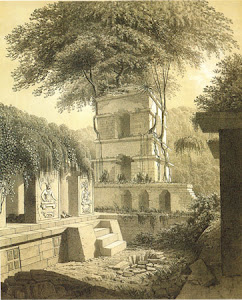Lámina 17: Interior del Edificio Principal de Kabáh_
_
__"El explorador entra a esta habitación e inevitablemente lo envuelve un aire de admiración y misterio. Esta es una de las cámaras de Kabáh, en la cúspide, alrededor del año 800 de nuestra era. Una traducción inglesa del nombre Maya es “la mano que esculpe.” Lo que no se pude apreciar del todo es una habitación paralela a la cámara principal. La oscura y privada cámara interior, puede haberse utilizado para almacenar el tributo, como los textiles, de gran valor y estima para los mayas. Toda el área, de la forma en que Catherwood la representa, irradia un aire de paz y elegancia, con sus techos altos y escaleras de entallados complejos que conducen hacia la profundidad de las ruinas.
__La cámara de Kabáh es característica del estilo Puuc que prevaleció durante un periodo de doscientos años (antes del año 1000 de nuestra era), e incluyó las ciudades de Labnah y Uxmal. El estilo arquitectónico Puuc mantiene un balance entre paneles simples y decorados. Bloques de mampostería (piedras talladas en grandes unidades para decoración), pirámides con cámaras, pasajes abovedados, fachadas verticales y entradas enmarcadas por columnas eran a menudo utilizados en el estilo Puuc. Mientras que en parte de la entrada se pueden apreciar tallados complejos, el resto de la habitación permanece de alguna manera desatendida. Otra característica del estilo Puuc son los techos altos que terminan en punta—o bóveda de voladizo. Se ha especulado que la bóveda Maya tenía nueve capas de piedra, que correspondían a las nueve capas del abismo y a los nueve Señores de la Noche". _
______________________
*_*_*_*_*_*_*
_
Plate 17, Interior of the Principal Building at Kabáh (on stone, by A. Picken)
_
__"An explorer steps into the room and is enveloped with a sense of awe and mystery. It is one of the chambers at Kabáh, at its peak around 800 CE (one English translation of this Maya name is “the hand that chisels”). What cannot be fully seen is a room running parallel to the main chamber. The dark, private interior chamber may have been used for the storage of tribute, such as textiles, which were treasured by the Maya. The entire space, as depicted by Catherwood, exudes a sense of peace and gracefulness, with its high ceilings and intricately carved stairs leading deep into the ruins.
__The chamber at Kabáh is characteristic of the Puuc style during the two hundred year period before 1000 CE in the eastern Yucatán peninsula, including the cities of Labna and Uxmal. The Puuc style of architecture maintains a balance between plain and decorated panels. Block masonry (stones carved in large units for decoration), chambered pyramids, archways, vertical façades, and apertures framed by columns were employed extensively in Puuc-style work. Although there are intricate carvings near the doorway, the remainder of the room remains somewhat understated. Also characteristic of the Puuc style is the tall ceiling that ends in a point—a corbel vault. Some have speculated that the Maya vault had nine stone layers, corresponding to the nine layers of the Underworld and the nine Lords of the Night".
_






 Gracias Tanja
Gracias Tanja








